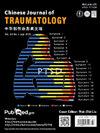Polytrauma-related deaths in Moscow: Retrospective analysis of 969 autopsy studies
IF 1.9
4区 医学
Q2 ORTHOPEDICS
引用次数: 0
Abstract
Purpose
Polytrauma is still a challenge for health care organizations. Today, the search for factors to reduce lethality continues. This study aims to describe the causes of death associated with polytrauma in 1 year.
Methods
This retrospective study analyzed autopsy data of trauma deaths in Moscow for the whole of 2017. We identified victims with polytrauma, taking into account the Berlin definition as the main inclusion criteria with penetrating and blunt trauma. Each forensic report had information about the pre-hospital and hospital stages of treatment and autopsy data. The exclusion criteria for this study were: isolated injury, forensic reports not related to the examination of entire corpses, and autopsy studies of children (<18 years old). Statistical analysis was performed according to basic principles, including a comparison of groups using the Chi-squared test with Bonferroni comparison test and Fisher's exact test. The critical level of significance (p value) in testing statistical hypotheses in this study was taken as 0.05.
Results
We analyzed 2337 forensic medical examinations of victims who died of trauma in Moscow in 2017, of which 41.5% (n = 969) were polytrauma deaths. Most of the victims (65.4%, n = 634) died on the scene, and only 30.0% were admitted to the hospital. The most frequent cause of death was bleeding (72.0%, n = 698), followed by traumatic brain injury (43.8%, n = 424). They accounted for the first peak (78.4%, p = 0.005) of deaths, occurring in the first hours. Then these causes of death in the first peak go down in a few hours, and the second peak of mortality appears in 3 – 7 days (p = 0.001).
Conclusions
This is the largest full-year autopsy study of polytrauma victims. Our data show that the main cause of polytrauma death is massive bleeding, with a lethality peak in the first hours after injury. The time distribution of polytrauma deaths has a bimodal pattern - the second period of polytrauma deaths occurs in 3 – 7 days.
莫斯科多创伤相关死亡:969例尸检研究的回顾性分析
目的:多发创伤仍然是卫生保健机构面临的挑战。今天,仍在继续寻找降低死亡率的因素。本研究旨在描述1年内与多发创伤相关的死亡原因。方法:本回顾性研究分析了2017年全年莫斯科创伤死亡的尸检数据。我们确定了多发创伤的受害者,将柏林定义作为穿透性和钝性创伤的主要纳入标准。每一份法医报告都有关于入院前和住院治疗阶段的资料以及尸检数据。本研究的排除标准是:孤立性损伤、与整具尸体检查无关的法医报告和儿童(受害者< 18岁)的尸检研究。统计分析按基本原理进行,包括组间比较采用卡方检验与Bonferroni比较检验和Fisher精确检验。本研究检验统计假设的临界显著性水平(p值)取0.05。结果:我们分析了2017年莫斯科创伤死亡受害者的2337例法医检查,其中41.5% (n = 969)为多重创伤死亡。大多数受害者(65.4%,n = 634)当场死亡,只有30.0%的人入院治疗。最常见的死因是出血(72.0%,n = 698),其次是外伤性脑损伤(43.8%,n = 424)。它们占死亡的第一个高峰(78.4%,p = 0.005),发生在头几个小时。第一个高峰的死亡原因在几小时内下降,第二个高峰出现在3 - 7天(p = 0.001)。结论:这是对多发创伤受害者进行的最大规模的全年尸检研究。我们的数据显示,多重创伤死亡的主要原因是大量出血,在受伤后的最初几个小时内死亡率达到高峰。多发伤死亡的时间分布呈双峰型,多发伤死亡的第二期发生在3 ~ 7天。
本文章由计算机程序翻译,如有差异,请以英文原文为准。
求助全文
约1分钟内获得全文
求助全文
来源期刊

Chinese Journal of Traumatology
ORTHOPEDICS-
CiteScore
3.80
自引率
4.80%
发文量
1707
审稿时长
28 weeks
期刊介绍:
Chinese Journal of Traumatology (CJT, ISSN 1008-1275) was launched in 1998 and is a peer-reviewed English journal authorized by Chinese Association of Trauma, Chinese Medical Association. It is multidisciplinary and designed to provide the most current and relevant information for both the clinical and basic research in the field of traumatic medicine. CJT primarily publishes expert forums, original papers, case reports and so on. Topics cover trauma system and management, surgical procedures, acute care, rehabilitation, post-traumatic complications, translational medicine, traffic medicine and other related areas. The journal especially emphasizes clinical application, technique, surgical video, guideline, recommendations for more effective surgical approaches.
 求助内容:
求助内容: 应助结果提醒方式:
应助结果提醒方式:


